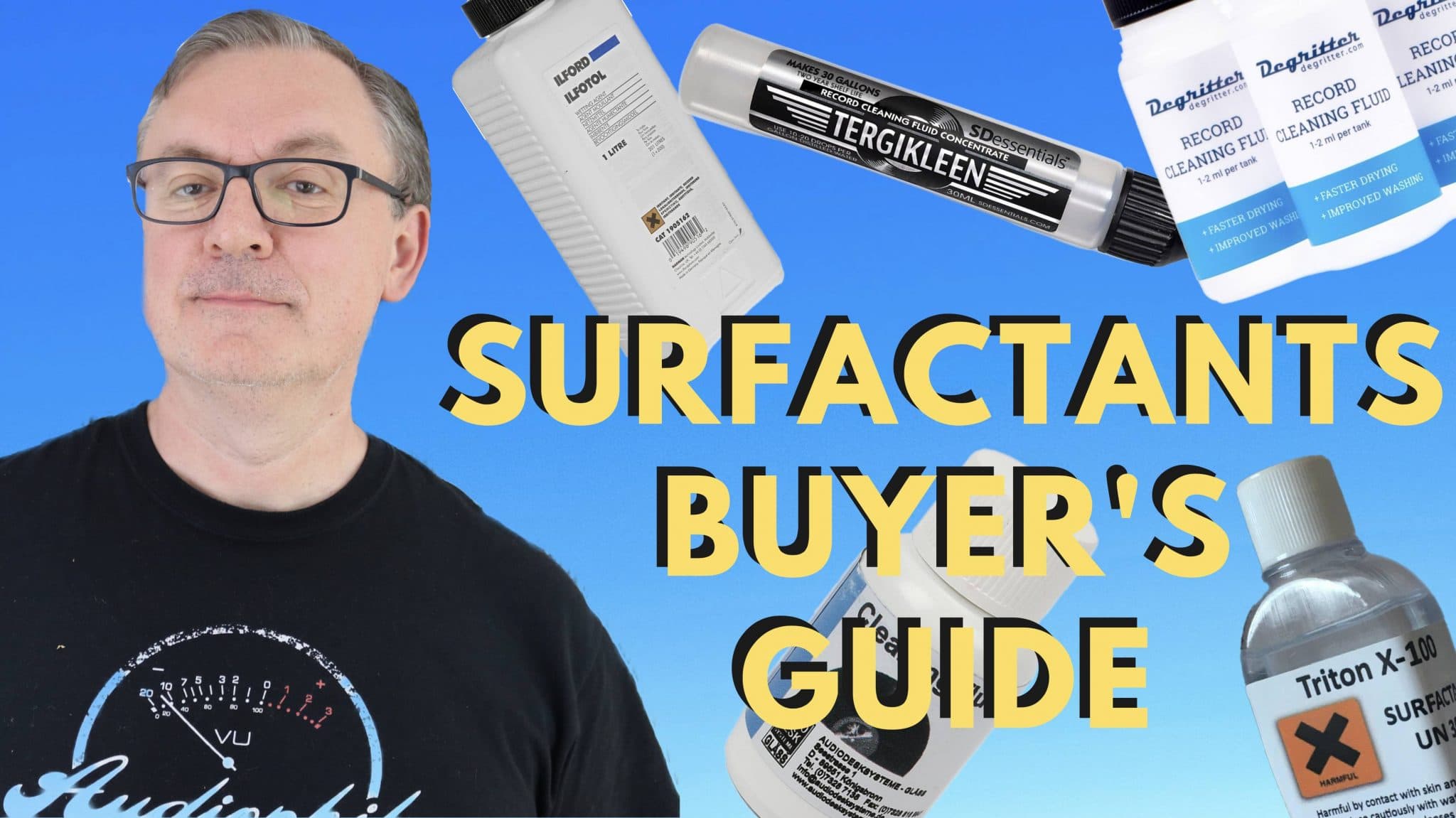The Article
SURFACTANT BUYER’S GUIDE: ON YOUTUBE
23rd September 2020

If you would like to see a video version of my recent Surfactant feature, then you may wish to give this one a go
One of the most important tools in the armoury of the vinyl fan, Paul Rigby asks what they are, why they’re important in terms of vinyl cleaning and which surfactants you should buy.
To see the video, click the image below…



Hi Paul,
I recently posted a comment abt cleaning cd’s. I forgot to mention that the first step was to wipe off the cd with Furutech’s pc-A fluid, which immediately improves the sound quite dramatically. I was told to spray on the surface (2-3 squirts) and spread with the provided wipe (soft side on the cd!) in a radial (not circular!) motion. I use a second provided wipe to dry off in the same fashion. All-in-all, a one-minute job. Another Furutech no-brainer. I found that one application was enough. Then run the cd over the gobble the gooks AR Ion Generator – or use the Destat III – before each play session.
I own an ADS ultrasound vinyl cleaner. It packed up after 5 years of light use (abt 500 records). I found out on the internet that many owners complain about their machines breaking down for an array of reasons. Not good given the exorbitant price. Anyhow, ADS agreed to exchange my kaput machine for its latest version – at a substantial cost. I am awaiting delivery. Hopefully, ADS sorted out the teething problems. Your viewers and readers should be warned never to buy a 2nd hand first generation ADS vinyl cleaner.
Now for your patient exploration of the best use of the ADS vinyl cleaner. As you wrote, on the dark side of the groove, without the cover of the warranty (anyhow pretty useless because it only gives cover for 2 years).
If I understand properly:
1. apply diluted tergikleen solution – 20 drops for 2 ltrs of distilled water Рwith pipette to the surface of the record. Is there a best application pattern? Roughly how many drops? Spread over the surface – with what?
2. turn over and repeat on the other side
3. no need to wait for the surfactant to react with the vinyl surface
4. clean the record in ADS vinyl cleaner; the vat of the ADS should contain only distilled water, to which abt 0.4% (by volume) isopropyl alcohol has been added.
I understand the above procedure yields much better sonic results than using ADS’s own surfactant (with which I have some issues). Is that correct?
I admire your patience. Thanks for sharing your experience!
Hi Jack – thanks for your question.
Decant your Tergikleen into a pipette bottle. This is the bottle design I use: https://www.amazon.co.uk/gp/product/B00IZOCRB8/ref=ppx_yo_dt_b_search_asin_title?ie=UTF8&psc=1
Add two pipettes of Glycol to the bottle.
This will prevent gravity pulling the Tergikleen from the grooves as the vinyl sits in the vertical position. Give me a shout if you need a contact for this.
Best application pattern is a cross shape at 12, 3, 6 and 9 o’clock on the disk to ensure an even spread. Each line of the cross running from the label edge to the outer edge. Then spread with a Kabuki brush (buy the best you can afford to prevent bristle shedding). Then move the fingers down the bristles to harden them and work the liquid into the grooves in a spiral pattern around the disc: clockwise then anti-clockwise.
Repeat on the other side.
And yes, no need to wait.
Fill the bath with distilled water and 7% alcohol. 1% will do the job. 7% is needed to melt the Glycol.
The Audio Desk liquid is good. Not great. That’s right.
A full feature on all of this will follow ASAP. But that will see you right for now 🙂
Hi Paul,
All clear. Thanks for taking the time to reply.
I will raid my wife’s cosmetics bag for an unused(!) kabuki brush (I had never heard of the term).
I ordered tergikleen from the US, it will take time to get here. In the meantime, the new ADS ultrasound cleaner has arrived. I will apply diluted AD liquid to my disks as you suggest and only add 1% alcohol to the bath. I will let you know. But please don’t expect the thoroughness of your fascinating investigations.
Thanks for the update Jack and for your kind words. Sure, please let me know how you get on. A brief summary is fine 🙂
Hi Paul, really enjoyed reading and viewing your reviews and advice regarding vinyl care. Consequently I have just purchased the Degritter and now awaiting my tube of Tergikleen. Can you please help with the following:- After applying the Tergikleen and Glycol mix to the vinyl with my Kabuki brush what do you recommend putting in the Degritter bath? The Degritter solution or Isopropanol solution and how much? You also recommend 6 deep cleans, does that mean going through Terikleen process each time and drying cycle after each wash? Any additional advice is appreciated, many thanks Chris.
Hi Chris – in the bath? if you’re using Glycol, 7% of alcohol (full strength), diluted into distilled water. So whatever, the bath quantity, 7% of that should be full strength alcohol. The Degritter solution is ok but no great shakes.
And yes, each cycle includes a drying period. Interminable, isn’t it? 🙂 Worth it, though.
I constructed a DIY US system….Chinese tank, and a Vinyl Stack Spinner to hold and rotate LPs. I use a spin clean then rinse as a pre-cleaner, then into the US tank for 15min at .33 rpm/ 5 full revolutions, at a temp of 30’c. Then rinse, then vac dry using a nitty gritty vac machine. I use “Rushton’s” formula in the US tank. His formula contains 91% alcohol, tergitol, hepastat and distilled water. Results are phenomenal.
The Hepastat sounds intriguing. Why did you choose that? Or did you follow the recipe from the 2016 Positive Feedback article?
Hepastat is an ingredient in Rushton’s formula, and was mentioned in his PF article.
Many thanks for this video and as I can’t wait for your next one giving more detail, I hope you don’t mind another question.
It’s regarding Triton X100. You recommend 20 micro drops into 2 lts of distilled water. I understand the micro drops are from the Triton bottle’s dropper.
I now refer to your reply to the first poster regarding Tergikleen. My queries are:-
1. Do I use the 2 litres of solution with or without glycol?
2. Is this 2 litre solution instead of the alchohol distilled water wash?
3. Do I used the Triton solution as a prewash, with the brush and action you describe in your first reply?
I have an early Monks machine so I currently use an alchohol based solution to clean and dry.
All the best, John
Hi John:
1: I decant some of that water into a pipette vial and add the Glycol to that vial only.
2: The water used for the surfactant is separate from the water I use for the bath. The bath water (as it where) holds a fixed amount of alcohol – 7% if Glycol is used.
3: Diluted Triton is used as a surfactant, yes. Applied directly to the vinyl with a pipette and brush.
Many thanks Paul. I should have also asked: when you say add 2 pipettes of glycol, is that 2 pipette drops or two full pipettes? Cheers
Two full pipettes, John – what you end up getting with a typical does is just over half way, in fact.
OMG, sorry for this. Is it Monopropylene Glycol or Propylene Glycol? I didn’t know there were two sorts – perhaps they are the same but I thought I’d ask.
Many thanks, John
Hi John – it’s the same thing. The only one you need to avoid is ethylene glycol, which is nasty stuff.
I hope to have a full cleaning guide on this site by the end of the eek s you might want to check in later to read that too.
Hi Paul
Just purchased a degritter using their cleaning fluid saw your you tube video on both the degritter and about Sufactants.
i will try your method Tergikleen quite hard to get hold of so will try Ilfotol first when you apply the sufactant directly to record can you use a spray bottle or does it have to be done with brush to make it more effective.
Thanks